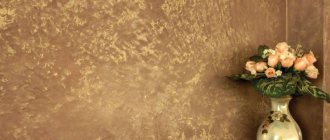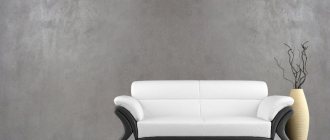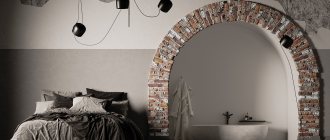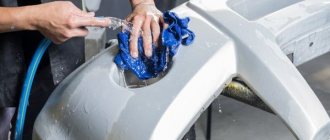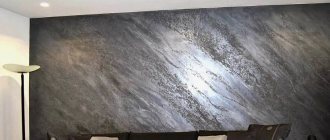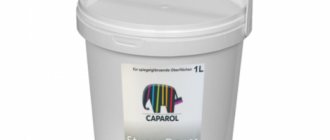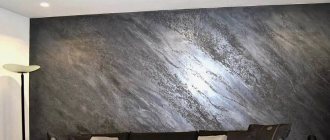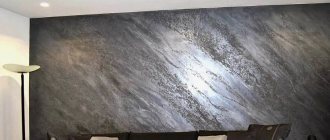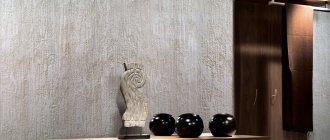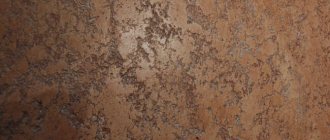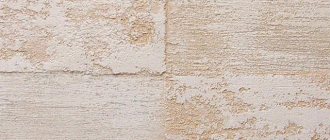The loft style interior is currently one of the most popular in the world. Residential and commercial premises are decorated with simple and multifunctional furniture, combining old stairs, unlined pipes with mirrors, and modern appliances. The result is a stylish interior for a relatively small amount of money.
A characteristic feature of the industrial style is the decoration of the walls with rough plaster, which imitates the rough texture of concrete. The advantage of a decorative coating for concrete is the ability to independently create a relief. It is worth remembering that in order to imitate concrete on a wall, you must choose high-quality materials and strictly adhere to the stages of their application.
Decorating the surface for concrete
Plaster that imitates the surface of concrete has become a popular type of decoration for rooms in the minimalist style. Walls with a “concrete effect” look durable, solid, monumental, even if they are built from plasterboard.
Users are attracted not only by the illusion of strength and reliability, but also by the minimalism of appearance. Plastered in this way, the wall imitates the surface before the renovation began. But when looking at her, there is no feeling of incompleteness.
Decorative plaster for concrete in the interior in this style is usually performed in rooms with a simplified, at first glance, general design.
Photo in the interior of a country house
The interior of a country house has more opportunities for realizing ideas. A simple fireplace with a concrete cladding will look gorgeous. The contrast of cold and hot will look impressive in the interior of the living room.
The photo shows a living room in the interior of a country house. The niche, finished with concrete panels, is fully utilized, combining a fireplace, a seating area and a place for logs.
With the help of concrete columns or small partitions, you can divide the space into zones without compromising the area, without interfering with natural light.
A minimalist staircase with railings is suitable for both classic and modern interiors.
Matching style
A minimum of things, furniture, muted colors, and discreet decor are generally called high-tech style. Premises decorated in this way can be used as a club or restaurant, as a rock studio or creative workshop, as a formal office space or as the home of a person who understands and loves art.
But there are no strict rules for home design. Therefore, in some cases it is advisable to install a bright sofa in the room or decorate one of the walls with abundant living greenery or flowers. Lighting is important, because twilight in a home with “concrete” walls causes a negative mood.
Without good lighting, such a room will look gloomy Source zebra100.ru
It is recommended to design concrete-look walls in rooms with high ceilings, preferably in large areas. A large space with bright lighting is associated with the naturalness of the loft style.
Composition of the plaster mixture
Manufacturers offer ready-made plaster mixtures in various versions. Conventionally, they can be divided into two groups: microcement and microconcrete. Both categories contain:
- Finely ground cement;
- Seeded sand of minimum fraction, cleared of impurities;
- Polymer additives that give the compositions specific properties.
In addition to the listed components, microconcrete contains mineral additives of a slightly larger fraction.
The ingredients are usually indicated on the packaging. The manufacturer's recommendations, rules for preparing the surface, mixing the mixture and applying plaster are also written there.
Examples of wall textures “like concrete” Source o-remonte.com
See also: Catalog of companies that specialize in finishing materials.
Properties and advantages of plaster
In addition to its appearance, which can be combined with any materials in the interior, decorative plaster “concrete” has a number of positive characteristics. The list of advantageous properties that allow us to consider the material universal and accessible in use:
- does not respond even to significant changes in humidity and air temperature in the room;
- does not require regular care;
- the plaster layer performs the function of retaining heat in the room, allowing you to significantly reduce heating costs;
- does not exert additional load or other undesirable effects on the original surface;
- easy to paint with any composition;
- can be used for an extremely long time without changing properties;
- applied to any surface with a high degree of adhesion;
- does not require high-quality smoothing or grinding;
- allows the use of stencils and stamps;
- work on applying plaster does not require high professional training;
- the surface texture is selected at the user’s request;
- Surface shades can be varied by adding regular acrylic dyes.
The addition of dyes makes the plaster more beautiful Source beton-house.com
How to make an archstone with your own hands
The creation of architectural products begins with the development of the desired shape. Having decided on what you want to make with your own hands, you can begin to select materials and methods to implement your plans.
Composition and proportions of cement mortar
To make objects, different concrete solutions are prepared. More often they resort to the recipes shown in table.
Art concrete application technology
Before starting work, a ready-made or self-made building mixture is diluted, the necessary pigments and decorative elements are added to it. Then they begin to apply plaster or pour art concrete into the mold.
Surface preparation
The base must be fairly level, dry, and free of dirt. All poorly adhering elements, old paintwork, and falling off plaster must be removed from it. Chips, holes, and cracks are repaired with regular cement mixture. Grease stains are wiped off with a degreaser. The surface is sanded with fine-grain sandpaper, dust is removed with a vacuum cleaner, and then primed with 2 layers.
Procedure for working with art concrete
The first layer of material is applied to the base and leveled with a spatula or trowel. After it dries, a second layer is performed, on which the selected pattern is formed with light movements of any convenient tool. As it partially dries, the edges of the design are smoothed out a little with a trowel.
If necessary, add individual strokes to imitate voids and cavities, cracks in concrete. The coating must dry for at least 15-24 hours at a temperature of about +22 degrees and humidity up to 65-70%. If the art concrete has not been tinted in advance, painting is done by spraying, stamping or painting over stencils.
Shaping products
Art concrete can be poured into any shape. To ensure that there are no voids inside, the material is compacted. Further work with the product is carried out only after it has thoroughly dried (usually after 2 days). To make the surface of the object smooth, it is ground, polished, and uneven surfaces are removed by sandblasting. In addition, the product is molded using the following methods:
- embossing with a relief roller or stamp (panels, bas-reliefs);
- vibration pressing (paving slabs);
- simple pressing (stucco molding, decorative elements).
Manufacturing technology
Filling forms are filled in in the following sequence.
- The molds are lubricated with a release agent. Used motor oil is used here.
- Wipe off excess grease.
- Arch concrete is being prepared.
- Pour it into the mold.
- Place the mold on a vibrating table, where air is removed from the mass.
- Set the filling to dry.
- Release the casting from the mold.
Elastic forms are used in a similar sequence. There is no need for disassembly. The shell is simply removed from the casting.
Sputtering
This method is used to apply paint, which should “turn” concrete into brick, or imitate natural stone. In this case, the acid dye is applied in layers to the uncured solution. The pigment reacts with the mixture, and the result is uniform coloring.
Using stencils
This simple method is used for decorating walls, painting flooring, and garden paths. You can buy stencils in a store, or make your own from any suitable material. For example, many craftsmen create templates from thick paper, cardboard, plastic, thin plywood, etc.
Printing (stamping)
This is the most labor-intensive method that requires physical effort. The first dies were made of aluminum. These were massive products with handles. Such matrices made it possible to imitate stone or brickwork, but creating complex textures with their help is impossible.
Now stamps are made from several materials:
- Made of silicone, polyurethane. They are cast on original materials, so the texture is almost completely identical. Another advantage is long service life. When using these soft materials, there is no need to lubricate the molds: the dies can be easily removed without damaging the surface.
- Plastic. These forms are rigid, but they can accurately and clearly convey all geometric shapes. The most popular stamps imitate brickwork and paving stones. With the help of plastic products you can transform any surface: both horizontal and vertical.
In the “printed case”, it is better to evaluate the degree of rigidity of the forms before purchasing.
The high density of the material guarantees a clear pattern. Excessively soft material is more difficult to work with and will require more effort when printing. The concrete mold stands out. It is laid next to the area where the work is being carried out. Then the concrete is poured and waited for it to harden. The finished element is removed, then the next one is poured, moving the stencil further. This method can be used to decorate any “section of the site”: a porch, a garden path, the floor of a terrace or gazebo, a place near a pool, a car parking lot.
All these stamp products can be bought, but many craftsmen prefer not to spend money, but to make them with their own hands. To create them, some readily available materials are suitable. Since this type of work can rightfully be considered the most labor-intensive, it is necessary to dwell on it in more detail.
Disadvantages of exclusive plaster options
Plaster has practically no disadvantages. In technological terms, some difficulties may be caused by the length of time the mixture hardens. But this indicator is not critical - it is somewhat worse from the economic side of the issue.
Creating exclusive interiors requires not only the cost of expensive raw materials, but also payment for design development and selection of individual mixture components.
Good design is far from the cheapest pleasure Source market.kz
Peculiarities
When choosing a composition, you should take into account the individual characteristics of not only the room being decorated, but also the concrete plaster itself in the interior:
- The structure of the plaster is porous and the surface is rough, this is caused by the content of mineral fillers and additives in it;
- The relief of the coating is achieved by sequentially applying several layers of the mixture;
- Preliminary preparation of the surface to be plastered consists of cleaning it from dust, dirt, and previous coatings;
- During work, you should use personal protective equipment, since the mixtures contain polymers that are harmful to health.
An example of combining plaster and other finishes Source connexionav.com
Description of material
Concrete has a characteristic, easily recognizable texture. It is slightly rough and has large and small pores. Its heterogeneous gray color belongs to the cold palette. Outwardly, all this looks unattractive, but at the instigation of the Japanese architect Tadao Ando, concrete began to play a fundamental role in the interior of living rooms. This was a bold decision; the master used it to create a trendy look for the house. Today this finish is very popular. It is chosen by creative people, extraordinary individuals who surround themselves with an exclusive space.
Monochrome cool color Source designerdreamhomes.ru
Concrete is a plastic material; when used correctly, it can reveal completely different properties. Modern designers today do not hide traces from the formwork structure, do not mask joining seams, on the contrary, they play up their presence in every possible way and, using other techniques, break stereotypes. Today, concrete walls in the interior look soft and warmer due to the placement of the right accents. Soft carpets, delicate textiles on the windows, velvety upholstery - all this prevents the atmosphere of a gloomy basement or bunker from forming.
Individual decorative elements soften the severity of concrete Source dhfa.mx.tl
Concrete goes well with other finishing materials. Its expressive texture emphasizes the warmth of wood and the severity of glass. This tandem became the basis for the implementation of industrial styles. If loft or constructivism, or any other rigid brutalist concept, is chosen for interior design, concrete must be used.
Decorators do not hide defects in the concrete surface, but emphasize them Source pobetony.expert
Offers from the top 5 manufacturers
There are many manufacturers of decorative plaster, but only some of them are constantly engaged in monitoring and improving the quality of their products. As a rule, these are well-known manufacturers who value their reputation:
- Prof Decor . A company from Russia produces decorative building materials in a wide range. Suppliers of initial components for plaster mixtures have been selected for the company over the years - only the best cooperate with this manufacturer. The company is distinguished from other manufacturers by the widest selection of colors and shades of plaster.
- San Marco . Decorative mixtures from this manufacturer are purchased by users who are interested in increased strength, moisture resistance and other increased characteristics. Similar parameters are required for plastering surfaces in non-standard and extreme conditions. The variety and excellent quality of polymers in mixtures is the strong point of the Italian manufacturer.
- "Flex Concrete System" . Decorative concrete for walls under this brand is used for surfaces that have direct contact with moisture or are subject to frequent overheating and temperature changes. A distinctive feature of the company’s products is the exact imitation of natural materials.
Original finishing solution Source stroyres.net
Types of wear-resistant paints for concrete with a decorative effect
Decorative paints are produced on a mineral, water and acrylic basis . Most professionals prefer acrylic samples, as they are more plastic; silicone can be added to the composition, which will provide additional water resistance. After the layer has dried, it can be washed without harming the coating. Mineral analogs are superior in terms of environmental friendliness. The finished coating is highly vapor permeable and does not attract dust. But the range of characteristics does not end there.
Silicate
Painting with this type of decorative paints gained popularity many years ago. The optimal solution for concrete foundations. The simple composition ensures durability and abrasion resistance, high adhesion. The finished film is resistant to fungi, mold, and moisture.
Advantages:
- weather resistance, which is valuable if decorative paint is used outdoors;
- air, vapor permeability;
- excellent adhesion;
- affordable price;
- fire resistance.
Flaws:
- does not work on silicone and acrylic old coatings;
- inferior to acrylic in the choice of pigments;
- color may fade.
Technical specifications:
- consumption – 0.4 kg/sq.m;
- base – potassium liquid glass;
- tinting according to sample;
- dry residue – 55%;
- density – 1.4 g/cc.
Brief technology:
The material works on old and new concrete bases, indoors and outdoors, including those covered with silicate and mineral plasters, except gypsum. Cover dry, clean, durable, repaired surfaces, without signs of icing. Use typical painting equipment.
Rubber paints for concrete
The material can be used indoors and outdoors. These are water-based paints that provide resistance to dirt and sudden temperature changes. Additionally, the composition includes acrylate latex, coalescent, and antifreeze. The finished layer is plastic and successfully resists fungi and mold, and is easy to wash and clean. This group includes latex (acrylic-silicate) paints.
Advantages:
- internal and external finishing of concrete;
- quick drying;
- excellent air and vapor permeability;
- gives an anti-slip effect on floors;
- ease of application;
- environmental friendliness;
- waterproofing;
- increased level of wear resistance;
- ability to stretch.
Rubber paints for concrete have increased wear resistance
Flaws:
- fast fading without protective coating;
- does not tolerate sunlight.
Technical specifications:
- mass fraction of non-volatile substances – 51%;
- hiding power – 125 g/sq.m.;
- degree of grinding – 50 microns;
- resistance to water – 24 hours;
- drying time – 1 hour;
- bending strength of the coating – 1 mm;
- adhesion – 1 point.
Brief technology:
Rubber paints are applied using brushes, rollers, and spray guns. The work is carried out under normal weather conditions, at temperatures above +5 degrees. To achieve the required viscosity, the material is diluted with water 5% by volume.
Acrylic
After drying, the material forms a film layer. These paints contain a special emulsion that protects concrete from damage and contamination. Good cleaning, ease of application, affordable price - these are the trump cards of this option.
Advantages:
- wide choice of colors;
- tightness and elasticity of the layer;
- water resistance;
- resistance to abrasion, alkali action;
- UV resistance.
Flaws:
- high price;
- toxicity of components.
Technical specifications:
- base – acrylic resins;
- external characteristics – matte, homogeneous layer;
- mass fraction of non-volatile substances – 70%;
- viscosity – 60-110 sec.;
- drying time – 10 hours;
- hiding power – 170 g/sq.m.;
- light fastness – 24 hours;
- impact strength of the coating – 40 cm;
- bending strength – 3 mm;
- resistance to water – 24 hours.
Brief technology:
Work on dry, cleaned, repaired surfaces. Hardening is carried out with acrylic primers. The paint is mixed, if necessary, diluted to the required viscosity. The material is spread with a sprayer, brushes, rollers in 1-2 layers.
Acrylic paints are capable of maintaining their appearance for a long time
Enamel
This group is represented by polyurethane and alkyd varieties. Both options simulate a durable film on the bases. I can say that this is a durable layer for interior concrete coatings.
Advantages:
- affordable price;
- ease of application;
- quick drying of the layer;
- resistance to humidity;
- Neutral to aggressive chemicals.
Flaws:
- In terms of wear resistance, it is inferior to analogues;
- low UV resistance;
- toxic components;
- low fire safety.
Technical specifications:
- viscosity – 60-120 min;
- drying period – 24 hours;
- content of non-volatile substances – 50-70%;
- bending strength – 1 mm;
- consumption – 80 g/sq.m.
Brief technology:
They work on previously prepared surfaces. Enamel paints can be diluted with solvents to a working viscosity of up to 15%. When painting, rollers, brushes, and spray guns are used. It is recommended to keep the material at +20 degrees for 24 hours.
Structural
Such decorative paints are often used for exterior and interior use. The composition of such materials is similar to plaster, which affects the application method. Application is carried out with a special roller; a thick layer is required.
Advantages:
- high decorative characteristics;
- easy application;
- masking minor defects.
Flaws:
- high price;
- difficult removal, care.
Technical specifications:
- consumption – 1 l/3.5 sq.m in two layers;
- Drying time – 2-4 hours.
Structural paints can mask minor defects without much repair
Brief technology:
The base must be cleaned, without major defects, and primed. When painting, the composition requires constant stirring. Work is carried out at temperatures above +5 degrees . The material is applied with a spatula, or less often with a roller. Structural paints can be applied in vertical stripes (traditionally) or in irregular movements (circular, diagonal), which will allow you to achieve an interesting external effect.
Practical recommendations
When using the material, it is advisable to be guided by practical rules compiled by masters based on experience and mistakes made:
- Rooms where all the walls are covered with decorative plaster do not look very good. Art-concrete plaster in the interior is in perfect harmony with all finishing materials. Therefore, as a contrast or to highlight a special zone in the room, it is allowed, and sometimes it is simply necessary, to use wood, glass, or metal. The shape and layout depend on the taste of the owner or the conditions of the project.
Combination of materials in decoration Source archilovers.com
- The choice of color combinations depends on individual preferences, but harmony is paramount.
- Ceilings can be plastered in the same way as walls, but the shades of the ceiling plaster should be lighter.
- Sharp contrasts in the interior with “concrete” walls are acceptable, but in very small proportions.
Proper use of contrast and accents makes the interior recognizable and original Source id.aviarydecor.com
- Decorative plaster is not intended for leveling the surface to be coated, sealing cracks, joints and potholes.
How to create a lime plaster effect
The gray coating Intonachino Minerale (Intonachino Minerale) from the San Marco brand will help create the effect of lime plaster on the wall. This mineral building material consists of airy lime with the addition of quartz sand, which allows you to achieve various decorative techniques. The company produces this type of coating in two versions: with grains of sand with a diameter of 0.7 millimeters (GF series) and particles of a slightly larger fraction - 1.4 millimeters (GM series).
It’s worth choosing the cladding depending on what result you want to see on the wall. If the structure should resemble porous shell rock, it is better to opt for fine-grained plaster. If you need to get a multifaceted texture that will be more similar to chipped oak bark, you should take a closer look at the GM series
Properties of textured plaster Intonachino Minerale:
- the first layer dries in about 2-3 hours, the next layer must be applied after 6 hours;
- due to its moisture resistance, the material can be used in bathrooms and kitchens;
- the plaster does not fade or lose its original appearance, and is resistant to mechanical damage (which is why pet owners often buy it);
- Available in finished form in containers of 1 kg and 25 kg.
To apply the composition, use a stainless steel or plastic trowel or a sponge roller. Consumption depends on the grain size: the smaller the diameter of the sand, the more mass is required. The material is applied in a thin layer. As soon as the composition begins to dry, you need to smooth the surface with a special sponge, creating the effect of ancient plaster.
Briefly about the main thing
Decorating the surface to look like concrete is an interesting and practical finishing solution.
Although in practice the concept of style is quite vague, you still need to adhere to a certain direction.
The finishing plaster composition is not intended for other work.
Plaster, as a finishing material, has no pronounced disadvantages, but the more colorful and varied the finish, the more expensive its cost will be.
A little more attention!
Write in the comments what you think - finishing with plaster can be considered as a new thing, or is it still a well-forgotten old thing - for example, echoes of Loft?
Ratings 0
Read later
